Code for the zigzag indicator with the use of array.
I compared it with the platform indicator, and the results are almost identical in both pips and percentage modes.
With the “Type” variable it is possible to switch the functioning between “Points” and “Percentage” (Note: in the case of ZZ in %, I used the Day Close of the previous day as a basis for calculation to give stability to the reference; using the ” close” with very low % values, sometimes the recalculation gives rise to graphical artifacts)
The “Segments” variable decides how many pairs of up/down segments to display on the graph.
|
1 2 3 4 5 6 7 8 9 10 11 12 13 14 15 16 17 18 19 20 21 22 23 24 25 26 27 28 29 30 31 32 33 34 35 36 37 38 39 40 41 42 43 44 45 46 47 48 49 50 51 52 53 54 55 56 57 58 59 60 61 62 63 64 65 66 67 68 69 70 71 72 73 74 75 |
//17/12/2022 - T.F. - ZigZag code with Array //Sharing ProRealCode DEFPARAM DRAWONLASTBARONLY=TRUE //Variables: //Points=20 //Pips //Perc=0.25 //% //Type=0 //0=pips; 1=perc //Segments=10 //n. segments up/dw to show PI=max(0,(Segments-1)) //points top/low back to store VarY=CustomClose //close,tpicalprice, etc //inizializzo primo punto come TOP once LastPoint = 1 once $TX[0] = barindex once $TY[0] = VarY //Tipo ZZ in Punti o Percentuale If Type=0 then //ZZ in pips DeltaY=max(2*pipsize,Points*pipsize) elsif Type=1 then //ZZ in % DeltaY=max(0.001,Perc/100*Dclose(1)*pipsize) //Dclose used as ref. endif //ZZ in fase 1 if LastPoint=1 then //lastpoint was a top if VarY>$TY[0] then //update last top and stay in LastPoint=1 $TY[0]=VarY $TX[0]=barindex elsif VarY<=($TY[0]-DeltaY) then //first point in low for i=PI downto 0 do //shift memory previous points $LX[i+1]=$LX[i] $LY[i+1]=$LY[i] next $LY[0]=VarY //store new low and change lastpoint $LX[0]=barindex LastPoint=-1 endif endif //ZZ in fase -1 if LastPoint=-1 then //lastpoint was a low if VarY<$LY[0] then //update last low and stay in LastPoint=-1 $LY[0]=VarY $LX[0]=barindex elsif VarY>=($LY[0]+DeltaY) then //first point in top for i=PI downto 0 do //shift memory previous points $TX[i+1]=$TX[i] $TY[i+1]=$TY[i] next $TY[0]=VarY //store new top and change lastpoint $TX[0]=barindex LastPoint=1 endif endif //---GRAPH--- If LastPoint=1 then drawsegment (barindex,VarY,$TX[0],$TY[0]) style (dottedline,2) COLOURED (0,0,200) //segment in progress for i=0 to PI do //final segments drawsegment ($TX[i],$TY[i],$LX[i],$LY[i]) style (line,2) COLOURED (0,0,200) drawsegment ($LX[i],$LY[i],$TX[i+1],$TY[i+1]) style (line,2) COLOURED (0,0,200) next endif If LastPoint=-1 then drawsegment (barindex,VarY,$LX[0],$LY[0]) style (dottedline,2) COLOURED (0,0,200) //segment in progress for i=0 to PI do //final segments drawsegment ($LX[i],$LY[i],$TX[i],$TY[i]) style (line,2) COLOURED (0,0,200) drawsegment ($TX[i],$TY[i],$LX[i+1],$LY[i+1]) style (line,2) COLOURED (0,0,200) next endif return |
Share this
No information on this site is investment advice or a solicitation to buy or sell any financial instrument. Past performance is not indicative of future results. Trading may expose you to risk of loss greater than your deposits and is only suitable for experienced investors who have sufficient financial means to bear such risk.
ProRealTime ITF files and other attachments :PRC is also on YouTube, subscribe to our channel for exclusive content and tutorials
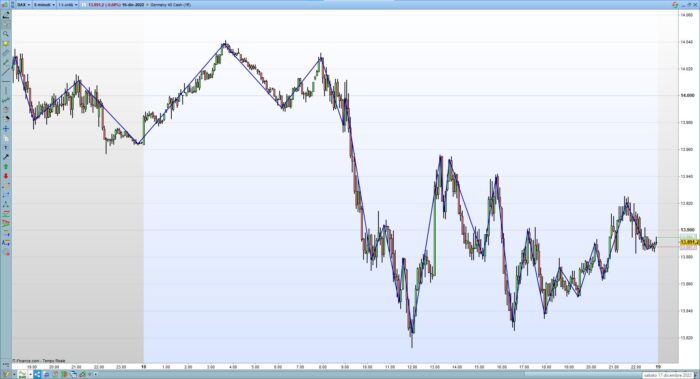

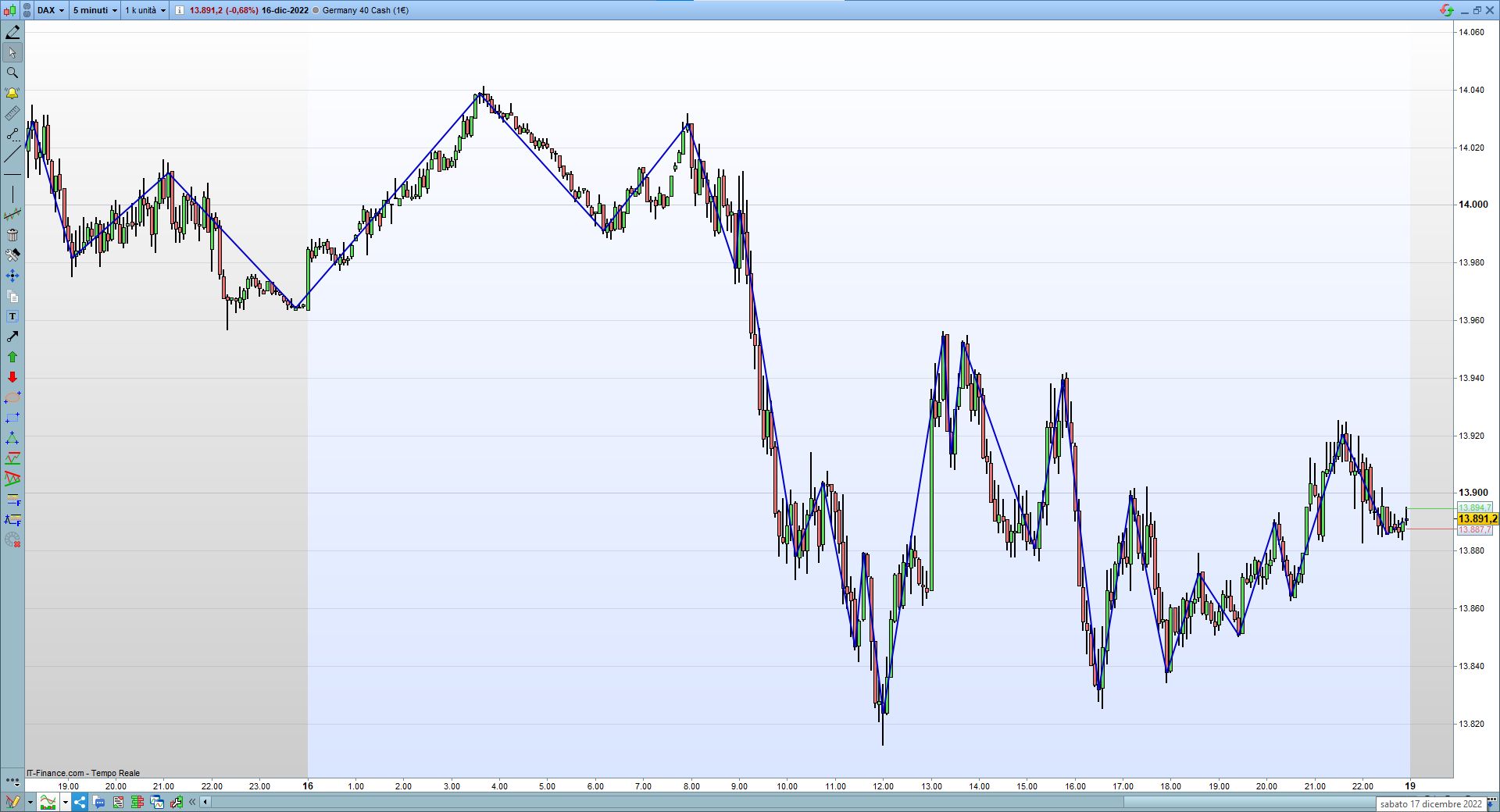
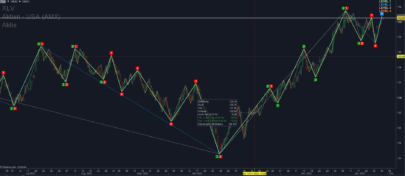
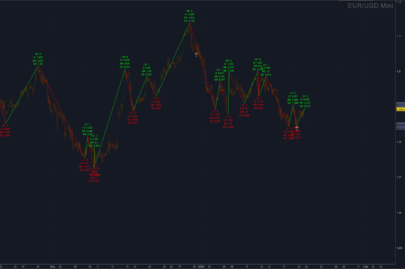
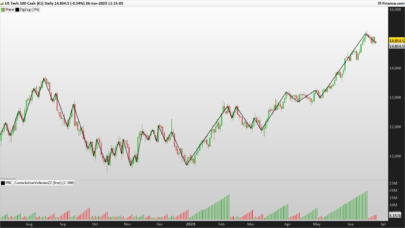
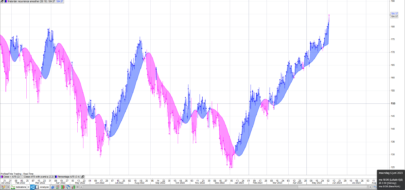
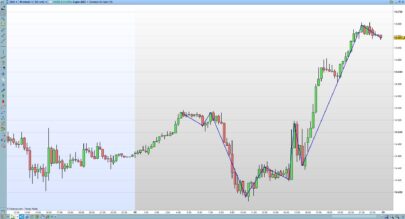


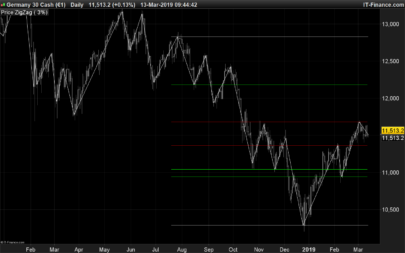
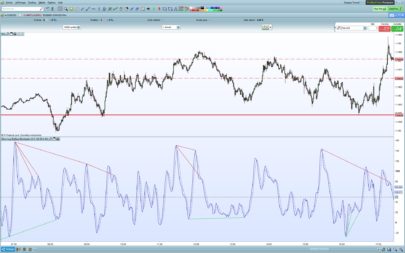
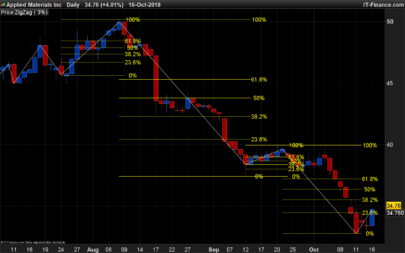


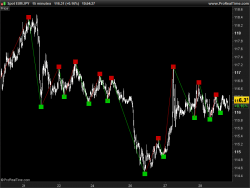
Hi, thanks for this code.
I implemented it successfully, however, I don’t see an indicator.
I mean: the zigzag line is drawn, but I cannot translate this line into an indicator or variable that can be used in a strategy.
Suppose we call this zigzagline “zigzag” then we can test the following pattern:
if zigzag[2]<zigzag[1] and zigzag[0]<zigzag[1] then
there is a (local) top that delivers a short signal,
and so on
Regards, Jerke vd Geest
The Netherlands
The coordinates of the zigzag points are stored in the arrays $TX,$TY (for tops) and $LX,$LY (for lows). The last point is stored in index 0, the previous point in index 1 and so on…
But the version I posted above had some problems which were fixed by Roberto (many thanks!), see link to discussion for the modification needed:
https://www.prorealcode.com/topic/zigzag-test-code-indicator/
For use in something like a “1-2-3 J.Ross” strategy, I suggest you to use version 1 that I posted later in the discussion, which draws the zigazag the traditional way, without using arrays , only for the last segments:
the coordinates of the last point are in the variables TX0, TY0 (top) LX0/LY0 (low), and the previous ones in TX1/TY1, LX1/LY1, TX2/TY2, LX2/LY2, etc.
With this version, a simple 1-2-3 strategy can be, for example, entering short when:
lastpoint=-1 (=price in descending phase), TY1>TY0 (=point 3<point 1 by Ross) and Close crosses under LY1 (=breakout point 2 by Ross) – [mirroring for long entering]
I'm also working on it 😉
//20/12/2022 – T.F. – V1: Codice ZigZag Versione v1: eliminati gli array e gestito con variabili fisse
//Sharing on ProRealCode
DEFPARAM DRAWONLASTBARONLY=TRUE
//Variabili:
//Punti=20 //Pips
//Percentuale=0.25 //%
//Tipo=0 //0=pips; 1=perc
VarY=CustomClose //close,tpicalprice, etc
//inizializzo primo punto come TOP
once LastPoint = 1
once TX0 = barindex
once TY0 = VarY
//Tipo ZZ in Punti o Percentuale
If Tipo=0 then //ZZ in punti
DeltaY=Punti*pipsize
elsif tipo=1 then //ZZ in %
DeltaY=Percentuale/100*Dclose(1)//usato Dclose come rif. per stabilità del valore
endif
//ZZ in fase 1
if LastPoint=1 then //ultimo punto era un massimo
if VarY>=TY0 then // aggiorno il punto di max e rimango in LastPoint=1
TY0=VarY
TX0=barindex
endif
if VarY<=TY0-DeltaY then //primo punto definitivo low
rem for i=PI downto 0 do //shift memoria punti precedenti
LX4=LX3
LY4=LY3
LX3=LX2
LY3=LY2
LX2=LX1
LY2=LY1
LX1=LX0
LY1=LY0
LY0=VarY
LX0=barindex
LastPoint=-1
endif
endif
//ZZ in fase -1
if LastPoint=-1 then //ultimo punto era un minimo
if VarY<=LY0 then // aggiorno il punto di min e rimango in LastPoint=-1
LY0=VarY
LX0=barindex
endif
if VarY>=LY0+DeltaY then //primo punto definitivo top
TX4=TX3
TY4=TY3
TX3=TX2
TY3=TY2
TX2=TX1
TY2=TY1
TX1=TX0
TY1=TY0
TY0=VarY
TX0=barindex
LastPoint=1
endif
endif
//—GRAFICA—
If lastpoint=1 then
drawsegment (barindex,close,TX0,TY0) style (dottedline,2) COLOURED (0,0,200) //segmento in progress
drawsegment (TX0,TY0,LX0,LY0) style (line,2) COLOURED (0,0,200) //segmenti definitivi
drawsegment (LX0,LY0,TX1,TY1) style (line,2) COLOURED (0,0,200)
drawsegment (TX1,TY1,LX1,LY1) style (line,2) COLOURED (0,0,200)
drawsegment (LX1,LY1,TX2,TY2) style (line,2) COLOURED (0,0,200)
drawsegment (TX2,TY2,LX2,LY2) style (line,2) COLOURED (0,0,200)
drawsegment (LX2,LY2,TX3,TY3) style (line,2) COLOURED (0,0,200)
drawsegment (TX3,TY3,LX3,LY3) style (line,2) COLOURED (0,0,200)
drawsegment (LX3,LY3,TX4,TY4) style (line,2) COLOURED (0,0,200)
drawsegment (TX4,TY4,LX4,LY4) style (line,2) COLOURED (0,0,200)
endif
If lastpoint=-1 then
drawsegment (barindex,close,LX0,LY0) style (dottedline,2) COLOURED (0,200,0) //segmento in progress
drawsegment (LX0,LY0,TX0,TY0) style (line,2) COLOURED (0,0,200) //segmenti definitivi
drawsegment (TX0,TY0,LX1,LY1) style (line,2) COLOURED (0,0,200)
drawsegment (LX1,LY1,TX1,TY1) style (line,2) COLOURED (0,0,200)
drawsegment (TX1,TY1,LX2,LY2) style (line,2) COLOURED (0,0,200)
drawsegment (LX2,LY2,TX2,TY2) style (line,2) COLOURED (0,0,200)
drawsegment (TX2,TY2,LX3,LY3) style (line,2) COLOURED (0,0,200)
drawsegment (LX3,LY3,TX3,TY3) style (line,2) COLOURED (0,0,200)
drawsegment (TX3,TY3,LX4,LY4) style (line,2) COLOURED (0,0,200)
drawsegment (LX4,LY4,TX4,TY4) style (line,2) COLOURED (0,0,200)
endif
return
Thanks for this!
My version uses highs and lows and uses 3 * ATR as the minimum difference between points:
DEFPARAM DRAWONLASTBARONLY=TRUE
//Variabili:
Punti=3 * averagetruerange[200] //Pips
Percentuale=0.25 //%
Tipo=0 //0=pips; 1=perc
//VarY=CustomClose //close,tpicalprice, etc
//inizializzo primo punto come TOP
once LastPoint = 1
once TX0 = barindex
once TY0 = close
//Tipo ZZ in Punti o Percentuale
If Tipo=0 then //ZZ in punti
DeltaY=Punti//*pipsize
elsif tipo=1 then //ZZ in %
DeltaY=Percentuale/100*Dclose(1)//usato Dclose come rif. per stabilità del valore
endif
//ZZ in fase 1
if LastPoint=1 then //ultimo punto era un massimo
if high>=TY0 then // aggiorno il punto di max e rimango in LastPoint=1
TY0=high
TX0=barindex
elsif low<=TY0-DeltaY then //primo punto definitivo low
rem for i=PI downto 0 do //shift memoria punti precedenti
LX4=LX3
LY4=LY3
LX3=LX2
LY3=LY2
LX2=LX1
LY2=LY1
LX1=LX0
LY1=LY0
LY0=low
LX0=barindex
LastPoint=-1
endif
endif
//ZZ in fase -1
if LastPoint=-1 then //ultimo punto era un minimo
if low<=LY0 then // aggiorno il punto di min e rimango in LastPoint=-1
LY0=low
LX0=barindex
elsif high>=LY0+DeltaY then //primo punto definitivo top
TX4=TX3
TY4=TY3
TX3=TX2
TY3=TY2
TX2=TX1
TY2=TY1
TX1=TX0
TY1=TY0
TY0=high
TX0=barindex
LastPoint=1
endif
endif
//—GRAFICA—
If lastpoint=1 then
drawsegment (barindex,high,TX0,TY0) style (dottedline,2) COLOURED (0,0,200) //segmento in progress
drawsegment (TX0,TY0,LX0,LY0) style (line,2) COLOURED (0,0,200) //segmenti definitivi
drawsegment (LX0,LY0,TX1,TY1) style (line,2) COLOURED (0,0,200)
drawsegment (TX1,TY1,LX1,LY1) style (line,2) COLOURED (0,0,200)
drawsegment (LX1,LY1,TX2,TY2) style (line,2) COLOURED (0,0,200)
drawsegment (TX2,TY2,LX2,LY2) style (line,2) COLOURED (0,0,200)
drawsegment (LX2,LY2,TX3,TY3) style (line,2) COLOURED (0,0,200)
drawsegment (TX3,TY3,LX3,LY3) style (line,2) COLOURED (0,0,200)
drawsegment (LX3,LY3,TX4,TY4) style (line,2) COLOURED (0,0,200)
drawsegment (TX4,TY4,LX4,LY4) style (line,2) COLOURED (0,0,200)
endif
If lastpoint=-1 then
drawsegment (barindex,low,LX0,LY0) style (dottedline,2) COLOURED (0,200,0) //segmento in progress
drawsegment (LX0,LY0,TX0,TY0) style (line,2) COLOURED (0,0,200) //segmenti definitivi
drawsegment (TX0,TY0,LX1,LY1) style (line,2) COLOURED (0,0,200)
drawsegment (LX1,LY1,TX1,TY1) style (line,2) COLOURED (0,0,200)
drawsegment (TX1,TY1,LX2,LY2) style (line,2) COLOURED (0,0,200)
drawsegment (LX2,LY2,TX2,TY2) style (line,2) COLOURED (0,0,200)
drawsegment (TX2,TY2,LX3,LY3) style (line,2) COLOURED (0,0,200)
drawsegment (LX3,LY3,TX3,TY3) style (line,2) COLOURED (0,0,200)
drawsegment (TX3,TY3,LX4,LY4) style (line,2) COLOURED (0,0,200)
drawsegment (LX4,LY4,TX4,TY4) style (line,2) COLOURED (0,0,200)
endif
return
A good alternative solution, even I had thought of the variant that uses high and low (probabily better than “Close”)
Another solution that I’m testing (and that seems to work very well when used on timeframe < day) is to use a % of the daily ATR as a parameter for the change of direction: 30% of the daily ATR value ( on 5 days, excluding today) seems to me the best one to follow the market swings on 15M. I use this setup for 1-2-3 strategy
Add at the The code:
time frame (1 day)
Atrd=AverageTrueRange[5](close)[1] //Average Daily max variations, today excluded to avoid recalculations on the ATRD value
time frame (default)
VarY=CustomClose //close,tpicalprice, etc
//initialize first point as TOP
once LastPoint = 1
ounces TX0 = barindex
ounces TY0 = VarY
//Type ZZ in Points or Percentage
If Type=0 then //ZZ in points
DeltaY=Points*pipsize
elsif type=1 then //ZZ in %
DeltaY=Percentage/100*Dclose(1) //used Dclose as ref. for value stability
//newtype=2
elsif type=2 then //ZZ in % on ATR Daily
DeltaY=PercOnATRD/100*Atrd //value in points calculated as % on atrd
endif
did you automate that 1-2-3 strategy? how is that working for you?
Not yet, I’m busy developing other strategies/indicators at the moment, but it’s on my to-do list 🙂
I think it’s not that complicated to make the basic 1-2-3 strategy using this ZigZag code.
As I said, with this version, a simple 1-2-3 strategy can be, for example, entering short when:
lastpoint=-1 (=price in descending phase), TY1>TY0 (=point 3<point 1 by Ross) and Close crosses under LY1 (=breakout point 2 by Ross).
Surely it is more difficult to make it efficient and filter it well to avoid consecutive losses in the lateral phases. Somehow we should take into account the basic trend, and block the strategy in moments of low volatility.
Even the type of money management (such as setting the target and the stop) can completely change the performance.